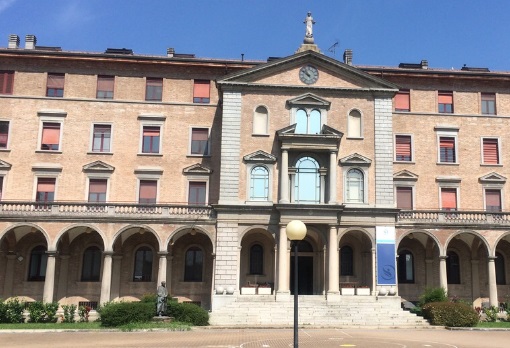1943-2003
Recalled by the late Ian English MC+ 2bars
It was in May 2002, during The San Martino Freedom Trail, which was based on the Europa Hotel in Sulmona, that Tony Woods came up to me at the bar and suggested a 60 year reunion at the old PG49 building at Fontanellato, to take place on the anniversary of the Italian Armistice which had taken place on 8-9 September 1943. The date seemed a long way ahead, but it happened.
When the Armistice between Italy and the Allies was declared on the 08 September 1943, there were two conflicting instructions prevailing:
- One was an order from the War Office in the UK, stating that in the event of an armistice, all prisoners of war should remain in their camps until given further orders.
- The second was an instruction from the Badoglio Government issued to as many Camp Commandants as could be reached, that steps should be taken to prevent Allied prisoners of war falling into the hands of the Germans.
Lt Col Hugo de Burgh, SBO (Senior British Officer) at Campo 49, had made an accurate appreciation that the Germans would try to gain control of POW camps in Italy, and as he was on amicable terms with the Camp Commandant Colonello Vicedomini at PG 49, the two men conferred and agreed that all 600 officers, and 50 other rank prisoners should be allowed to leave the camp in the event of an armistice. The SBO gave orders that, although the situation was uncertain, everyone should be prepared to leave at a moment’s notice.
On mid-day on the 9th September, the alarm was sounded (three ‘G’s’ on a bugle). Bringing with us all that we could carry, everyone formed up into companies and marched out through a gap cut in the wire, then hid up in a previously recc’d area along the wooded banks of the Rovacchia stream, about eight km away from Fontanellato. Many people from the town and the surrounding areas, knowing where we were, brought food and civilian clothing for those who wanted them. They told us that after we had left the Germans had arrived and were furious to find that ‘the birds had flown’. After two days in hiding we were given the order to break into small parties and move away, aiming to join up with the Allies, because we were too vulnerable in our position and in such a large group.
It was this event which we remembered and celebrated sixty years later, in September 2003. Our reunion group consisted of: 9 veterans, 8 wives or widows, 19 children, 8 children in law, and 11 grandchildren. After gathering in the courtyard of the old prison building – now a hospital, of which the Italians are justly proud – we were given a tour of the facilities. Although everything was much the same from the outside, the interior was very different. The only thing that I recognised was the marble staircase. We then took part in a moving Italian/English service in the chapel of the hospital; led in Italian by Don Reverberi – the parish priest, and in English by The Rev Bill Bowder, son of a Fontanellato prisoner. The order of service was taken from service sheets used in WW2, which had been discovered in the Imperial War Museum by Caroline Bowder.
In the afternoon we viewed a small exhibition of maps, photographs, letters, and other
Memorabilia from wartime days. This was followed by dissertations from Italians, speeches by the Mayor, Maris Guareschi, and Proferror Minardi (Director of the Resistance Museum at Parma), and English veterans shared their memories of 1943. One old Italian lady, who had taken food to the prisoners, said she would do the same thing again if she had to. The day finished with a formal dinner, to which the Mayor, the deputy head of the Cardinal Ferrari Hospital, Professor Minardi, and the welcoming committee of the commune were invited. At this event I presented hard copies of my book ‘Home by Christmas’ to those Italians who had helped to organise the reunion.
The main celebration took place on the 9th September, the anniversary of the day we broke out from the camp. There was an address by the Mayor, expertly translated by a young Italian lady; followed by a reply in Italian by Stuart Hood who, after leaving PG49 in 1943, had led a band of partisans in the mountains near Florence. Then there were short prayers in both languages, one minute of silence followed by the sounding of three ‘G’s’ on a trumpet and a symbolic cutting of barbed wire, after which the veterans led a march out. Unfortunately it poured with rain all morning, and most spectators had to leave their seats in order to take shelter.
A picnic had been planned at the Rovacchia stream near the spot where we had hidden in 1943, but because of the weather this was moved to a house nearby, in a large room with an arched ceiling and hooks for hanging hams. This was ideal for our purpose; tables were set out and we sat down to enjoy delicious thin slices of Parma ham, chunks of Parmesan cheese, local wine and grapes galore. All the visitors were given presents, the atmosphere was infectious, and the party concluded with singing and even dancing. In the afternoon some veterans went up into the hills to the villages where they had stayed in September 1943, although there were many new houses the churches and a few old buildings were still recognisable from 60 years before.
So ended a very memorable occasion, which had been expertly organised by Tony Woods and Dorothy Kennedy, a son and a daughter of former Fontanellato prisoners who had both succeeded in re-joining the British Army in the south, and one of whom was with us to tell the tale, sixty years on.

